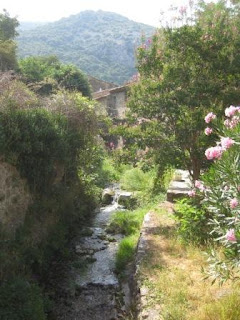This time I'll introduce you two nearby masterpieces of Roman architecture and engineering. I am still stunned by how far advanced the Romans were perhaps 1600 years ago. Both structures are world class. They are the Pont du Gard (the aqueduct across the Gard river near Nimes) and the theatre at Orange near Avignon in the Rhone Valley. Again, go to Google to find out more about these MASSIVE structures! Here is the Pont du Gard. Do you recall seeing images of it in history books? By the way, I'm not the massive structure I was referring to!
Can you think of any modern aqueduct that rivals this for size?
And now to Orange. The theatre below, which is still in use today, can seat 10,000 people!!!! It is the most perfectly intact such theatre in the world! Enjoy it as we did.
Fabulous! You'll have to wait a while for postings on Lyon (where Emily once stayed for a few weeks), Nancy (home of the Dukes of Burgundy), Metz (after which a local Gorge in my home region of New England was named), the Roman city of Trier (now in Germany of course), the Moselle valley, and Cologne. I've made a record number of postings for one day already.
AS
Can you think of any modern aqueduct that rivals this for size?
And now to Orange. The theatre below, which is still in use today, can seat 10,000 people!!!! It is the most perfectly intact such theatre in the world! Enjoy it as we did.
Fabulous! You'll have to wait a while for postings on Lyon (where Emily once stayed for a few weeks), Nancy (home of the Dukes of Burgundy), Metz (after which a local Gorge in my home region of New England was named), the Roman city of Trier (now in Germany of course), the Moselle valley, and Cologne. I've made a record number of postings for one day already.
AS


















































